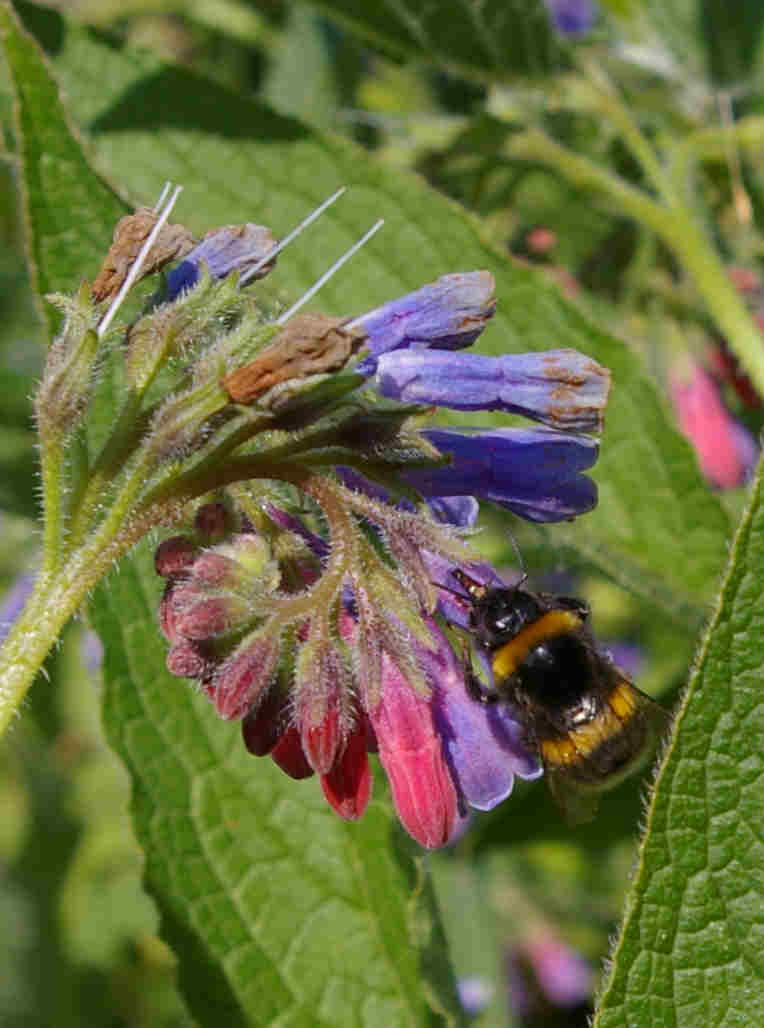Bombus terrestris
- The Buff-Tailed Bumblebee
Yesterday (18th Feb 2014), I saw my first Bombus terrestris queen of the year. It was a relatively mild day, the sun was shining (as it is today), and the sky quite clear. The bumble bee could easily have been missed, but when you are interested in all kinds of things ‘bee’, you tend to notice these low, quiet and gentle buzzing sounds.
I was taking our spaniel, Charlie for a walk, and immediately stopped and looked about me in the direction of the buzzing sound. Then I saw her.
I have to say, she was not as large as Bombus terrestris queen bumble bees I have previously seen, but I am quite sure of the species, and that a queen is what she was, particularly due to the time of the year and also because of her behaviour.
The queens emerge from hibernation, and begin looking for food and nesting sites. This queen buff-tailed bumble bee was flying low around dense ivy and scrubby undergrowth, prospecting for a nest site.
The
particular location she was searching in, is a great place for all types
of
bees. Throughout spring, summer and
autumn, this particular scrubby bank and the quiet country lane it
occupies, is
covered with perfect plants for bees (according to the time of year),
including
comfrey, brambles, forget-me-nots, dandelions, clover, wild roses, red
dead
nettle, gorse, bluebell, burdock, thistles, ragwort, vetches, knapweed
and poppy.
Then there are the gardens nearby – including mine, and a fabulous reservoir, woodland and nature reserve at the bottom of the lane.
Foraging habits of Bombus terrestris
I’m always
thrilled to see the first bumble bee queens emerging from hibernation, but I
always feel slightly nervous.
Immediately, I look about me to see if there are ample food sources to
get them off to a good start.
Unfortunately, the catkins on the trees down the lane are not yet ‘ripe’, nor are the pussy willows, the daffodils are not yet showing us their sunshine faces, and there is no pulmonaria in sight. Similarly, I have forget-me-nots in my garden looking like they may open soon, but not just yet.

However, I am at least seeing flowers the Bombus terrestris are able to feed on, including crocus
and Erica. Of course, I cannot see what is available in
other people’s gardens. Perhaps there
are mahonia, rhododendrons, blackthorn and others available (sadly, we lost our mahonia
and rosemary bush, and due to the changes we made in our garden last year, we
haven’t yet replaced them).

Buff-tailed bumble bees are polylectic, meaning they will forage on a large variety of plants, and are one of the species known to engage in nectar-robbing. Buff-tailed bumble bees have short tongues. Last year, I saw Bombus terrestris nectar robbing comfrey and managed to snap a picture (below). There is a huge swathe of comfrey by a reservoir where I live, so it's bumble bee heaven in summer!
Recognising Bombus terrestris
Queens can be about 20mm in length. In comparison with Bombus lucorum, the tail is usually a creamy or dull off-white, rather than bright white. The yellow bands can be very dark yellow – almost mustard-like, and sometimes quite narrow.
Workers are smaller than queens, with a white or whitish tail but with a ‘transitional’ zone between the tail and the black segment of the abdomen.
Males are similar to queens but smaller, but have ginger yellow hairs on the hind tibiae, becoming more yellow toward the top. Very occasionally, all black specimens may be seen.
 Buff-tailed bumblebee on Verbena
Buff-tailed bumblebee on VerbenaNests
Buff-tailed
bumble bees like to nest under the ground in abandoned mammal holes, with a
tunnel entrance.
Colonies
The colonies can
be relatively large with up to 350 workers.
Some workers act as guard bees at the entrance of the tunnel, raising
alarm and being ready to sting intruders if necessary.
Parasites
The cuckoo-bee, Bombus vestalis, is known to target Bombus terrestris. Read more about cuckoo bumble bees.
That the Bombus terrestris is the first bumble bee I have seen this year, is no surprise. They are one of the first species to emerge, and are even known to be active through the winter in parts of the UK.
Now, which species will I see next? I expect it will be Bombus lucorum (White tailed bumble bee) or Bombus pratorum (Early bumble bee). We shall see!
Read more about bumble bees
- Is It Bumble Bee Or Bumblebee? Is It Written As One Word Or Two? Although both are used widely, here's an explanation as to why, according to the Entomological Society of America, it should be written as two words.
- The Bumble Bee Life Cycle - A Description, Photos And Video The bumble bee life cycle starts with an impregnated queen when she emerges from her nest from her winter snooze. She feeds and seeks a suitable place to nest.
- Bumble Bee Nests: Nesting Preferences Of Different Bumble Bees, and challenges in finding suitable locations for nesting.
- Bumble Bees All about bumble bees - their life cycles, pollination, and answers to common questions.
- Do Bumble Bees Make Honey? Bumble bees store nectar in little wax pots for feeding the colony as it grows, but it is not really quite the same thing as honey made by honey bees.